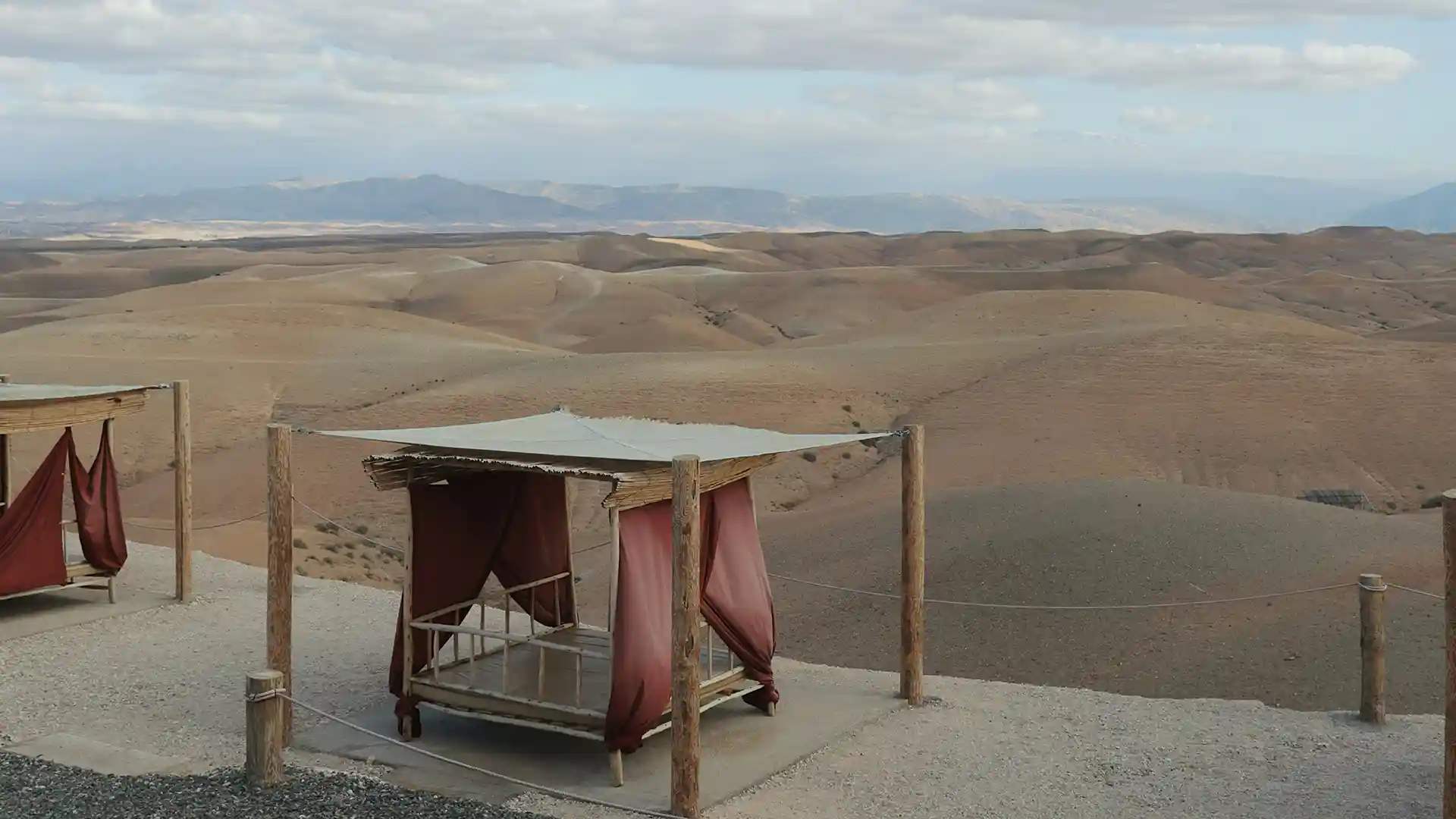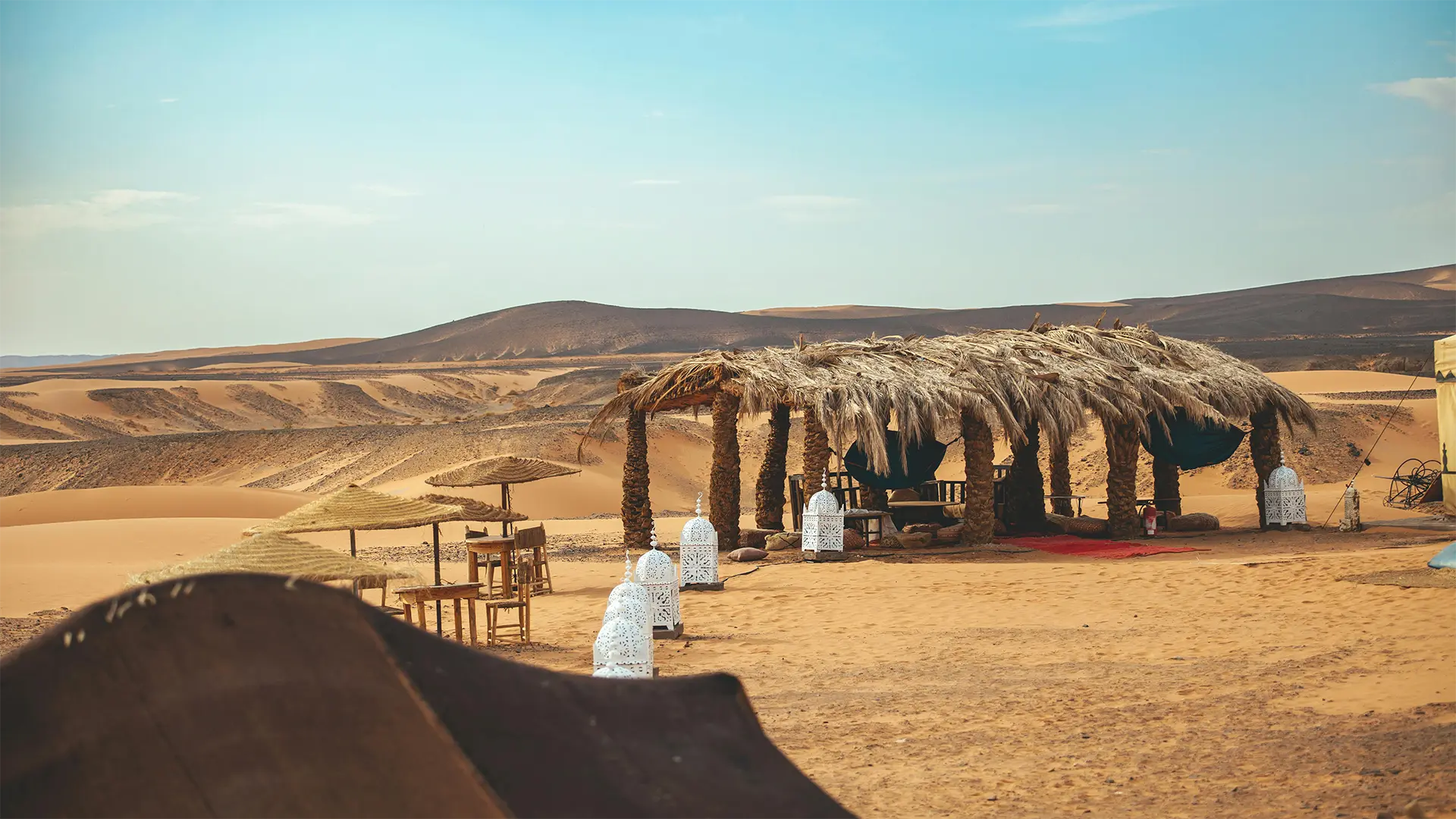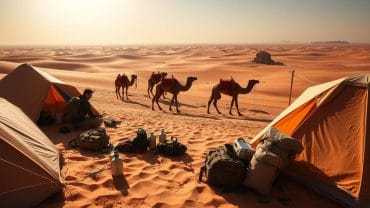Introduction: Understanding the Tourism Integrity Crisis
Morocco’s desert tourism industry faces a growing challenge that threatens its reputation and the trust of international visitors. The emergence of misleading “desert experiences” has sparked serious concerns among tourism professionals and authentic desert operators. This comprehensive guide examines the Agafay Desert controversy and provides essential information for travelers seeking genuine Sahara experiences.
What is the Agafay Desert Controversy?
The Agafay Desert scandal refers to the marketing of a rocky, non-desert terrain as an authentic Sahara experience. This area, located in certain regions of Morocco, lacks the fundamental characteristics that define true desert landscapes. Unlike genuine desert destinations such as Merzouga or M’hamid El Ghizlane, the Agafay area consists primarily of rocky terrain and sparse vegetation.

Key Issues Identified:
- Misleading Marketing: The area is promoted as a “desert experience” despite lacking sand dunes and authentic desert characteristics
- Tourist Deception: Visitors expect traditional Sahara landscapes but encounter rocky terrain instead
- Impact on Authentic Operators: Legitimate desert tour operators in established regions face unfair competition
How to Identify Authentic Desert Destinations in Morocco
Recognized Authentic Sahara Locations:
Merzouga (Erg Chebbi)
- Features towering sand dunes reaching up to 150 meters
- Offers traditional camel trekking experiences
- Provides authentic Berber camp accommodations
- Located in the Sahara Desert proper
M’hamid El Ghizlane (Erg Chigaga)
- Showcases vast golden sand dunes
- Offers remote desert experiences
- Features traditional nomadic culture
- Provides authentic desert camping
Zagora Region
- Gateway to the Sahara Desert
- Offers shorter desert excursions
- Features traditional kasbahs and palm groves
- Provides cultural desert experiences

Red Flags for Inauthentic Desert Tours:
- Proximity to Major Cities: Genuine desert experiences require significant travel time from urban centers
- Rocky Terrain: Authentic deserts feature sand dunes, not primarily rocky landscapes
- Lack of Traditional Elements: Missing camel treks, Berber camps, or traditional desert activities
- Unrealistic Pricing: Extremely low prices may indicate compromised quality or authenticity
Impact on Morocco’s Tourism Industry
Negative Consequences:
Visitor Disappointment
- Tourists receive experiences that don’t match expectations
- Negative reviews impact Morocco’s tourism reputation
- Reduced likelihood of return visits or recommendations
Industry Credibility
- Authentic operators face unfair competition
- Overall trust in Moroccan tourism decreases
- International tour operators may become hesitant to promote Morocco
Economic Impact
- Reduced tourism revenue in authentic desert regions
- Job losses for legitimate desert guides and operators
- Decreased investment in quality tourism infrastructure
Guidelines for Choosing Authentic Desert Experiences
Research and Verification Steps:
- Verify Location: Confirm the exact location of your desert experience
- Check Reviews: Read detailed reviews from recent visitors
- Examine Photos: Look for authentic sand dunes in promotional materials
- Verify Operators: Choose established, licensed tour operators
- Ask Specific Questions: Inquire about the type of terrain and activities included
Essential Questions to Ask Tour Operators:
- What type of terrain will we encounter?
- How far is the location from the nearest city?
- Are there actual sand dunes at the destination?
- What traditional desert activities are included?
- Can you provide references from recent clients?
Supporting Ethical Tourism Practices
How Travelers Can Help:
Choose Responsible Operators
- Research tour companies thoroughly
- Select operators with strong ethical standards
- Support businesses that employ local communities
Leave Honest Reviews
- Share accurate experiences on travel platforms
- Highlight both positive and negative aspects
- Help future travelers make informed decisions
Report Misleading Practices
- Contact tourism authorities about deceptive marketing
- Share concerns with travel booking platforms
- Support industry accountability initiatives
The Role of Technology and Social Media
Digital Verification Tools:
Google Earth and Maps
- Verify actual terrain through satellite imagery
- Check distances between cities and desert locations
- Identify genuine sand dune formations
Social Media Research
- Review recent visitor photos and videos
- Check location tags for accuracy
- Examine user-generated content for authenticity
Travel Forums and Communities
- Consult experienced travelers’ recommendations
- Join Morocco-specific travel groups
- Seek advice from desert tourism specialists
Regulatory and Industry Response
Current Initiatives:
Tourism Authority Actions
- Increased monitoring of tour operators
- Enhanced licensing requirements
- Stricter advertising standards
Industry Self-Regulation
- Professional associations promoting ethical practices
- Certification programs for authentic operators
- Collaborative efforts to maintain standards
Conclusion: Protecting Morocco’s Desert Tourism Legacy
The Agafay Desert controversy highlights the critical importance of authenticity in tourism marketing. Morocco’s genuine Sahara experiences represent centuries of cultural heritage and natural beauty that deserve protection and promotion. By choosing authentic operators and supporting ethical tourism practices, travelers can help preserve these invaluable experiences for future generations.
The tourism industry must prioritize transparency, authenticity, and visitor satisfaction to maintain Morocco’s reputation as a premier desert destination. Through collective effort from authorities, operators, and travelers, we can ensure that Morocco’s desert tourism continues to offer the genuine, transformative experiences that the Sahara Desert is renowned for worldwide.
This article aims to educate travelers about authentic desert experiences while supporting ethical tourism practices in Morocco. Always verify tour operators and destinations independently before booking any desert excursions.
Frequently Asked Questions
What is the Agafay Desert controversy in Morocco?
The Agafay Desert controversy refers to misleading tourism marketing where rocky, non-desert terrain is promoted as an authentic Sahara desert experience. This area lacks the characteristic sand dunes, desert landscapes, and cultural elements that define genuine Sahara destinations like Merzouga or M’hamid El Ghizlane. The controversy has raised concerns about tourism integrity and visitor deception in Morocco’s desert tourism sector.
How can I identify authentic Sahara desert tours in Morocco?
To identify authentic Sahara tours, look for these key indicators:
Location verification: Genuine tours go to established desert areas like Merzouga (Erg Chebbi) or M’hamid El Ghizlane (Erg Chigaga)
Sand dunes presence: Authentic experiences feature actual sand dunes, not rocky terrain
Travel distance: Real desert tours require significant travel time from major cities
Traditional elements: Include camel trekking, Berber camps, and cultural activities
Proper licensing: Choose operators with valid tourism licenses
Realistic pricing: Extremely low prices often indicate compromised quality
What are the best authentic desert destinations in Morocco?
Morocco’s top authentic desert destinations include:
Merzouga (Erg Chebbi): Features towering sand dunes up to 150m high, traditional camel treks, and luxury desert camps
M’hamid El Ghizlane (Erg Chigaga): Offers remote desert experiences with vast golden dunes and nomadic culture
Zagora Region: Serves as the gateway to the Sahara with shorter excursions and traditional kasbahs
Foum Zguid: Provides off-the-beaten-path desert experiences with authentic Berber hospitality
Each destination offers unique experiences while maintaining authentic Sahara characteristics and cultural heritage.
How do fake desert tours impact Morocco’s tourism industry?
Fake desert tours significantly harm Morocco’s tourism industry through:
Visitor disappointment: Leading to negative reviews and reduced repeat visits
Reputation damage: Undermining Morocco’s credibility as a premium desert destination
Economic impact: Reducing revenue for authentic operators and local communities
Industry credibility: Causing international tour operators to lose confidence in Moroccan offerings
Cultural preservation: Threatening the livelihood of traditional desert communities who depend on authentic tourism
Long-term consequences: Potentially deterring future investment in quality tourism infrastructure
What should I do if I’ve been misled by a fake desert tour?
If you’ve experienced a misleading desert tour:
Document everything: Take photos and keep all booking communications
Leave honest reviews: Share your experience on TripAdvisor, Google Reviews, and booking platforms
Contact authorities: Report to Morocco’s tourism ministry or local tourism offices
Seek refunds: Contact your booking platform or travel insurance if applicable
Warn others: Share your experience in travel forums and social media to help future travelers
Support authentic operators: Choose legitimate desert tour companies for future trips
How can I verify a desert tour operator before Reservation?
To verify a desert tour operator:
Check licenses: Ensure they have valid tourism operation permits
Read recent reviews: Look for detailed, recent customer feedback across multiple platforms
Verify location: Use Google Earth to confirm the actual desert location
Ask specific questions: Inquire about exact destinations, terrain type, and included activities
Request references: Ask for contacts of recent customers
Check social media: Review their social media presence for authentic customer photos
Contact directly: Speak with the operator by phone to assess their knowledge and professionalism
What’s the difference between Erg Chebbi and Erg Chigaga?
The main differences between these authentic desert destinations are:
Erg Chebbi (Merzouga): More accessible, larger dunes (up to 150m), more developed tourism infrastructure, closer to luxury accommodations
Erg Chigaga (M’hamid): More remote and wild, longer journey required, fewer crowds, more traditional nomadic experience
Activities: Both offer camel trekking and desert camping, but Erg Chigaga provides a more authentic, undeveloped experience
Access: Erg Chebbi is easier to reach, while Erg Chigaga requires 4WD vehicles for the final approach
Size: Erg Chebbi covers about 50km², while Erg Chigaga spans approximately 40km²
When is the best time to visit Morocco’s Sahara Desert?
The optimal times for Sahara desert visits are:
Best months: October to April when temperatures are moderate (15-25°C/59-77°F during day)
Peak season: November to March with comfortable weather and clear skies
Shoulder seasons: October and April offer good weather with fewer crowds
Avoid: May to September due to extreme heat (up to 50°C/122°F)
Special considerations: December-February nights can be very cold (near freezing), so pack warm clothing
Ramadan: Check dates as some services may be limited during the holy month
What should I pack for an authentic desert tour in Morocco?
Essential items for a Sahara desert tour:
Clothing: Light, breathable fabrics for day; warm layers for night; long sleeves and pants for sun protection
Sun protection: High SPF sunscreen, sunglasses, wide-brimmed hat
Footwear: Closed-toe shoes for camel riding; sandals for camp
Personal items: Headlamp/flashlight, personal medications, wet wipes, lip balm
Photography: Extra batteries, memory cards, protective camera bag
Comfort items: Small pillow, sleep mask, earplugs
Cash: For tips and small purchases (ATMs are rare in desert areas)
Are Morocco desert tours safe for solo travelers and families?
Yes, authentic Morocco desert tours are generally safe when booked with reputable operators:
Solo travelers: Choose established companies with good safety records; inform others of your itinerary
Families: Many operators specialize in family-friendly experiences with appropriate activities for children
Safety measures: Reputable operators provide experienced guides, emergency communication, first aid supplies
Accommodation: Desert camps maintain safety standards and provide secure, comfortable lodging
Transportation: Licensed operators use well-maintained vehicles with experienced drivers
Health considerations: Ensure you have travel insurance and any necessary medications


Comment (0)